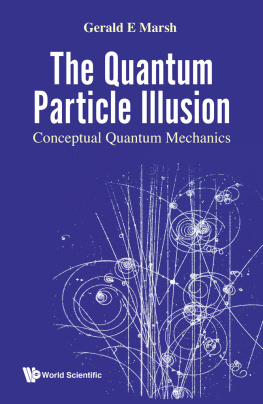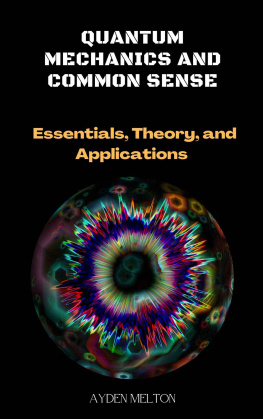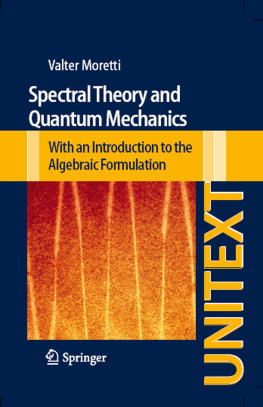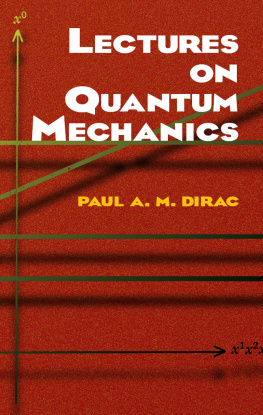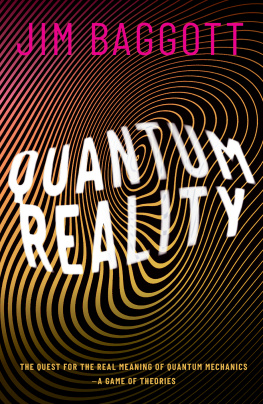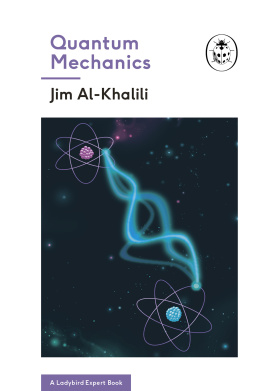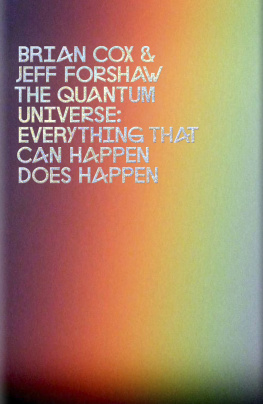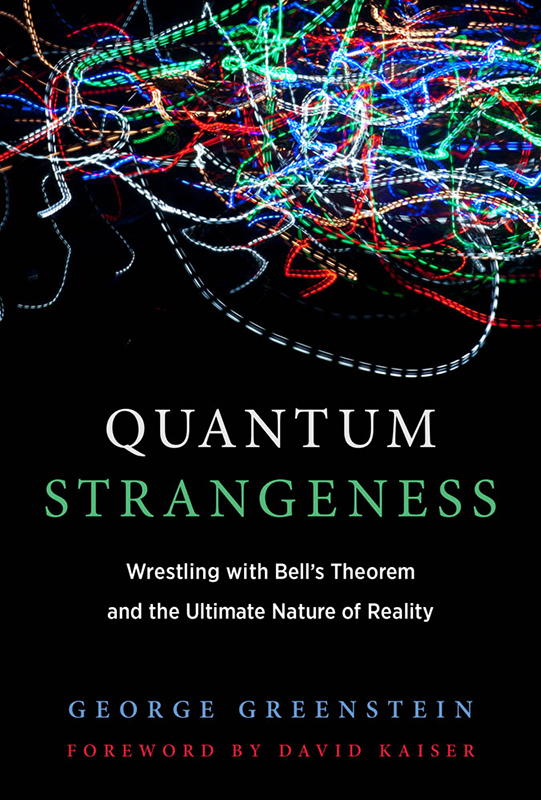Contents
Guide
Pagebreaks of the print version
Quantum Strangeness
Wrestling with Bells Theorem and the Ultimate Nature of Reality
George Greenstein
The MIT Press
Cambridge, Massachusetts
London, England
2019 Massachusetts Institute of Technology
All rights reserved. No part of this book may be reproduced in any form by any electronic or mechanical means (including photocopying, recording, or information storage and retrieval) without permission in writing from the publisher.
This book was set in Stone Serif by Westchester Publishing Services. Printed and bound in the United States of America.
Library of Congress Cataloging-in-Publication Data
Names: Greenstein, George, 1940- author.
Title: Quantum strangeness : wrestling with Bells Theorem and the ultimate nature of reality / George S. Greenstein ; foreword by David Kaiser.
Description: Cambridge, MA : The MIT Press, [2019] | Includes bibliographical references and index.
Identifiers: LCCN 2018043232 | ISBN 9780262039932 (hardcover : alk. paper)
Subjects: LCSH: Bell, J. S. | Quantum theory. | Physics--Philosophy.
Classification: LCC QC174.12 .G7325 2019 | DDC 530.12--dc23 LC record available at https://lccn.loc.gov/2018043232
To Guy Blaylock and Arthur Zajonc
Close friends, valued colleagues, and fellow Wrestlers
I think I can safely say that nobody understands quantum mechanics.
Richard Feynman, The Character of Physical Law
Contents
by David Kaiser
List of Figures
A typical tabletop quantum experiment. These experiments are not particularly spectacular to look atbut their results can be earthshaking. (This one is an experiment by David Hall of Amherst College, on a quantum phenomenon known as a BoseEinstein condensate.) Photo by George Greenstein.
Albert Einstein. Although he was one of the creators of quantum mechanics, he never accepted it. Over and over again, Einstein argued that the theory was incomplete because it failed to describe subatomic reality. The arguments that Einstein advanced are the fertile soil from which grew the discoveries described in this book. Photo courtesy of the American Institute of Physics Emilio Segre Visual Archives.
Niels Bohr. Also one of the creators of quantum mechanics, Bohr argued that Einsteins search for a more complete theoryone that would describe microscopic realitywas misguided. Indeed, Bohr argued, the refusal of quantum theory to do so was not a problem but a discoverya profound philosophical insight. Photo courtesy of the American Institute of Physics Emilio Segre Visual Archives.
Bohr and Einstein in the midst of a furious battle? Although they disagreed profoundly, their disagreements were never personal. In fact, they had deep affection and respect for one another. Photo courtesy of the American Institute of Physics Emilio Segre Visual Archives.
A spinning object and its axis of spin.
Naive view of the entangled state. It makes intuitive sense, but it will turn out to be wrong.
The spin axis of Alices electron points along one of the indicated directions.
The spin axis of Bobs electron points along one of the indicated directions.
Bobs detector points in a different direction than Alices.
The electron that reaches Bob has one of the indicated spin axes.
When do Bobs and Alices measurements agree?
John Bell lectures. His famous theorem showed that no local description of submicroscopic reality could make the same predictions as quantum mechanics. On the blackboard behind him can be seen a segment of this famous theorem (at the top). Photo courtesy of CERN.
John Bell and his wife Mary at dinner with friends. Mary Bell is also a physicist: indeed, the two Bells often collaborated. Photo Renate Bertlmann.
Clauser later in life. John Clauser performed the first pioneering experiments on Bells Theorem. Bell had shown that we have not one but two theories: one is quantum mechanics, and the other is some theory that would fully describe the reality underlying quantum phenomena. Clauser realized that an experiment could be done that would tell us which was correct. His result favored quantum mechanics. Photo courtesy of John Clauser.
Alain Aspect. Clausers experiment had a potential loophole: that somehow the two entangled particles could communicate with one another. Aspect closed that loophole by randomly changing the questions asked of them.
Anton Zeilinger. Clausers experiment had another potential loophole: that the questions asked of the two particles only seemed random, but were in fact being dictated by some unknown mechanism. Zeilingers experiment showed that this mechanism, if it existed at all, lay far off in the universe and operated far back in the past. Photo courtesy of the Mind & Life Institute, The Mind & Life Institute.
Carlos Abelln (left) and Morgan Mitchell (right). Photo: ICFO.
Are the questions asked of the two particles really random? All previous experiments had relied on some physical mechanism to achieve randomnessbut mechanisms obey the laws of classical physics, and so are not truly random. In the the BIG Bell Test experiment vast numbers of people were enlisted to use their free will to create randomness.
The app they created. Image: Maria Pascual (Kaitos Games).
Jian-Wei Pan at an experiment. Photo courtesy of the Micius Group.
Launch of the Micius Satellite. Photo courtesy of the Micius Group.
The Micius Satellite.
Jian-Wei Pan is the leader of a group that launched a quantum machine into orbit about the earth. This machine, the Micius satellite, has been used to securely transmit a cryptographic key from one place to another, and to teleport a quantum state from one place to another. Photo courtesy of the Micius Group.
Foreword
Physics has more than its share of mind-bending ideas: the slowing clocks and shrinking meter sticks of relativity; enormous coagulations of matter, like black holes, that can rupture space-time itself. Yet the strangest ideas of all are clustered in quantum theory, physicists remarkably successful description of matter and energy at atomic scales. Here we find descriptions of objects that seem to act as if they were in two places at once; of particles that can tunnel through walls; of Erwin Schrdingers twice-fated cat, trapped in a zombie-like state of being both alive and dead. For all that, Schrdinger himself declared one idea in particular, quantum entanglement, to be the characteristic trait of quantum mechanics, the one that enforces its entire departure from classical lines of thought.
Schrdinger had done so much to contribute to quantum theory; his wave function, obeying an equation he first published in 1926, remains central to physicists efforts to describe quantum systems quantitatively. Almost a decade later, in 1935, Schrdinger coined the term entanglement, though by then his enthusiasm for quantum theory had begun to wane. That same year his friend Albert Einstein teamed up with two younger colleagues, Boris Podolsky and Nathan Rosen, to issue his own, latest challenge to quantum theory. In their famous EPR paper (named for the authors initials), they described a system involving a pair of entangled particles emitted from a central source. Physicists could perform various measurements on one particle, and thereby learn something about the second particle, far off in the distance. Indeed, the EPR authors concluded, physicists should be able to glean



